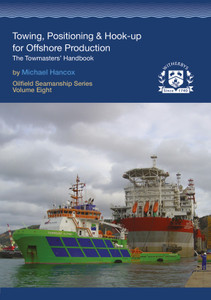
This book will benefit Masters, officers and other personnel operating anchor handling vessels. It describes the most common work boat operations, which differ to those of the barge or vessel being worked. A number of specialist mooring operations are also described, again from the boat’s viewpoint. Previously published by Clarkson Research Services Ltd.
This
volume
of
the
Oilfield
Seamanship
Series
provides
practical
guidance
on
all
aspects
of
anchor
handling,
such
as
anchor
retrieval,
rigging
for
anchor
handling
and
recovery
gear
for
fishing
and
grappling
operations.
The
book
is
supported
by
extensive
diagrams,
illustrating
sequences
such
as
breaking
out
anchors
and
the
stowage
of
chain
on
deck,
as
well
as
equipment
design.
Part
1
Introduction
1.1
Preamble
1.2
Characteristics
of
anchor
handling
vessels
Part
2
Equipment
Layout
and
Function
2.1
Standard
deck
layouts
AHT
and
AHTS
2.2
Guide
pins,
stoppers
and
similar
equipment
2.3
Stern
rollers
and
stern
gates
2.4
Anchor
handling
winches
2.5
Thrusters,
rudders
and
nozzles
2.6
Control
station
layouts
2.7
Anchors,
wire
rope,
shackles
and
gear
Part
3
Rigging
for
Anchor
Handling
3.1
Introduction
3.2
Deck
rigged
for
anchor
handling
–
permanent
chain
chaser
(PCC)
system
3.3
Deck
rigged
for
anchor
handling
–
buoyed
system
3.4
Deck
rigged
for
laybarge
anchor
handling
–
suitcase
buoys
3.5
Equipment
preparations
for
anchor
handling
3.6
Inventory
of
anchor
handling
equipment
3.7
Spooling
up
pennant
wires
3.8
Workwires
–
length
and
amount
in/out
3.9
Pulling
power
of
winches
Part
4
Running
and
Retrieving
Anchors
4.1
Permanent
chain
chaser
(PCC)
systems
–
operational
notes
4.2
Running
out
to
anchor
–
operational
notes
–
chain
chasers
4.3
Retrieval
–
operational
notes
4.4
Breaking
out
the
anchor
–
operational
notes
and
breakout
forces
4.5
Decking
anchor
–
PCC
system
4.6
Running
and
retrieving
anchors
–
two
boats
4.7
Buoyed
mooring
systems
–
components
4.8
Buoys
–
general
information
4.9
Running
to
location
–
buoyed
system
4.10
Retrieving
anchors
–
buoyed
mooring
systems
notes
Part
5
Laybarge
Anchor
Work
5.1
Characteristics
of
laybarge
anchor
work
including
barge/tug
dialogue
phrases
5.2
Sequence
of
events
Part
6
Fishing
and
Grappling
Operations
6.1
Introduction
6.2
How
it's
done
–
setting
up
the
gear
6.3
Methods
of
recovery
6.4
Cautions
6.5
Hints
on
recovery
6.6
Specifications
of
useful
recovery
gear
6.7
Common
mooring
chain
specifications/sizes
6.8
Running
anchors
over
obstructions
6.9
Unusual
anchor
handling
methods
–
without
use
of
winches
and
surface
pennants
6.10
Unusual
anchor
handling
methods
–
ultra
deep
water
Part
7
Handling
Chain
7.1
Operations
where
chain
handling
is
required
7.2
Routine
operations
7.3
Non-routine
operations
7.4
Basic
checks
including
chain/locker
capacity/volume
calculations
7.5
Tools
and
equipment
for
chain
handling
7.6
Rigging
up
for
handling
chain
into
lockers
7.7
Cautions
and
hints
7.8
Stowage
of
chain
on
deck
7.9
Marking
chains
7.10
Making/breaking
links
7.11
Assembly/disassembly
of
links
–
notes
7.12
Cutting
chain
7.13
General
chain
handling
notes
Part
8
Support
Mooring
Operations
8.1
Introduction
8.2
Pre-laid
mooring
systems
–
introduction
8.3
Pre-laid
moorings
–
types
8.4
Testing
pre-laid
moorings
8.5
Installation
of
single
point
mooring
spread
–
example
Part
9
Safety
Procedures
9.1
Anchor
handling
safety
–
general
9.2
General
safety
precautions
9.3
Clothing
of
deck
crew
9.4
Lighting
9.5
Communications
9.6
Deck
organisation
for
safety
–
tool
box/rack,
high
visibility
paint,
tugger
wire
ends,
using
wire
rope/chain
strops
9.7
Avoid
injury
9.8
Crew
team
work
9.9
Securing
pennant
wire
eyes
in
karm
forks/shark
jaws
9.10
Securing
anchors
and
buoys
Part
10
Maintenance
of
Equipment
10.1
Deck
equipment
10.2
Wire
rope
inspection
Part
11
Boat/Barge
Cooperation
11.1
Understanding
the
operation
and
operational
planning
11.2
Assisting
the
barge
11.3
Inspection
and
repair
of
equipment
11.4
Machinery
breakdown
11.5
Working
within
'the
boats'
limitations
11.6
Log
books
and
records
Part 12 Checklists – Examples
Part
13
Boat
Handling/Avoiding
Danger
13.1
Basic
techniques
13.2
Walking
sideways
13.3
Using
wind
and
tide
13.4
Running
anchors
across
wind
and
current
13.5
Avoiding
and
recognising
danger
13.6
PosCon
systems
13.7
Working
bow/stern
to
weather
13.8
'Slip
over'
problems
13.9
Trimming
the
boat
for
anchor
handling
13.10
Avoiding
damage
–
damage
and
breakage
of
pennant
wires,
damage
to
rudders,
nozzles
and
propellors
Part
14
Anchor
Positioning
Equipment
14.1
General
remarks
14.2
Laser
range
finding
14.3
Tug
management
systems
14.4
Echo
sounding
systems
Part
15
Useful
Tables,
Formulae
and
Data
15.1
Common
types
of
oilfield
high
holding
power
anchors
15.2
Mooring
line
calculations
–
formula
abbreviations
note
on
units
15.3
Mooring
line
catenary
data
–
nomenclature
15.4
Mooring
line
calculation
formulae
–
suspended
length,
touch
down
distance,
horizontal
tension,
vertical
tension,
catenary
depth,
distance
between
suspension
points
15.5
Use
of
catenary
formula
–
example
15.6
Tables
of
hyperbolic
functions
15.7
Chart
–
anchor
system
holding
capacity
in
mud
15.8
Chart
–
anchor
system
holding
capacity
in
sand
15.9
Soil
and
drag
anchor
capacity
15.10
Ways
to
improve
anchor
performance
15.11
Fluke
shank
angle
Michael Hancox
Captain Michael Hancox is a Marine Consultant and former Director of Hancox Marine Services Limited.
Witherbys
Witherbys
titles
are
developed
using
scripts
developed
by
technical
experts
that
are
peer
reviewed
within
work
groups.
Typically,
they
seek
to
improve
understanding
of
the
regulations,
recommendations
and
guidelines
issued
by
Industry.
Witherbys staff have significant expertise in the fields of navigation and hazardous cargoes as well as in the presentation of complex subjects in a graphic and easy to understand manner.
- Number of Pages:
- 314
- ISBN:
- 9781870945493
- Published Date:
- May 1994
- Binding Format:
- Paperback
- Book Height:
- 300 mm
- Book Width:
- 210 mm
- Weight:
- 1.2 kg
- Author:
Michael Hancox
- Preview:
- Yes
 Witherbys.com
Witherbys.com





